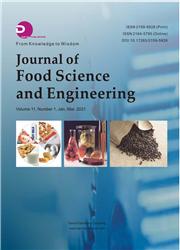Chemical Composition and Antioxidant Activity of Date Seeds from Different Tunisian Date Palm Cultivars
引用次数: 4
Abstract
Chemical composition, polyphenolic and flavonoid contents, and antioxidant activity were determined in date seeds derived from four Tunisian date palm (Phoenix dactylifera) cultivars namely: Goundi, Chekena, Mnekher and Remtha. Sodium and potassium contents in date seeds were determined by flame photometry, phenolic compounds by the Folin-Ciocalteu method, flavonoids by colorimetric quantification, and the antioxidant activity by the DPPH free radical scavenging method. Crude protein content varied widely (p < 0.001) between date seed varieties and ranged from 3.95 (Goundi) to 7.51 % DM (Chekena). No significant differences (p > 0.001) were detected between seed varieties for their dry matter (DM) and ash contents. However, sodium, potassium and phosphorus varied widely (p < 0.001) between varieties. The highest phenolic content (p < 0.001) was observed in Goundi (39.4 mg gallic acid equivalent (GAE)/g DM) and Remtha (36.6 mg GAE/g DM) seed varieties. Likewise, Goundi had the highest (p < 0.001) flavonoid content (16.4 mg quercetin equivalent (QE)/g DM) and antioxidant activity (1,807 μM Trolox equivalent antioxidant capacity (TEAC)/g DM); however the lowest values (p < 0.001) of phenolic (19.2 mg GAE/g DM), flavonoid (8.8 mg QE/g DM) and antioxidant activity (682 μM TEAC/g DM) were observed for Chekena seeds. Further studies are needed to verify the potential of date seeds as alternative for animal nutrition.不同突尼斯枣树品种枣种子化学成分及抗氧化活性研究
测定了四个突尼斯椰枣品种(即Goundi、Chekena、Mnekher和Remtha)的椰枣种子的化学成分、多酚和类黄酮含量以及抗氧化活性。采用火焰光度法测定椰枣种子中的钠和钾含量,采用Folin-Ciocalteu法测定酚类化合物,采用比色定量法测定黄酮类化合物,并采用DPPH自由基清除法测定抗氧化活性。不同枣种子品种的粗蛋白质含量差异很大(p<0.001),范围从3.95%(Goundi)到7.51%DM(Chekena)。不同种子品种的干物质(DM)和灰分含量没有显著差异(p>0.05)。然而,钠、钾和磷在不同品种之间差异很大(p<0.001)。在Goundi(39.4 mg没食子酸当量(GAE)/g DM)和Remtha(36.6 mg GAE/g DM)种子品种中观察到最高的酚类含量(p<0.001)。同样,Goundi的类黄酮含量最高(p<0.001)(16.4mg槲皮素当量(QE)/g DM),抗氧化活性最高(1807μM Trolox当量抗氧化能力(TEAC)/g DM;然而,Chekena种子的酚类(19.2 mg GAE/g DM)、类黄酮(8.8 mg QE/g DM)和抗氧化活性(682μM TEAC/g DM)的值最低(p<0.001)。还需要进一步的研究来验证椰枣种子作为动物营养替代品的潜力。
本文章由计算机程序翻译,如有差异,请以英文原文为准。
求助全文
约1分钟内获得全文
求助全文

 求助内容:
求助内容: 应助结果提醒方式:
应助结果提醒方式:


